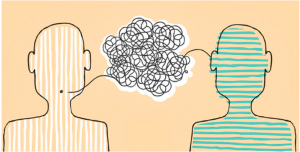Teaching is telepathy. When teaching goes well, it is far more mind-blowing than any blindfolded mystical stage act. It’s telepathy because what is in one person’s mind – the teachers, is transferred into the mind of another – the pupil. It’s a simple exercise complicated only by the idiosyncrasies of the two people invested in the exchange – teacher and learner.
When teaching goes well, it is far more mind-blowing than any blindfolded mystical stage act
 Let me teach you something about guitars. Think of a guitar. The guitar is divided into three parts, the body – which, on an acoustic guitar is the wide empty bit with the hole in it and on an electric guitar is the wider, often coloured bit of solid wood, let’s say this one is like a sea green. Next is the neck – the long bit that leads from the body to the top of the guitar and over which the strings are tightened to make the sounds. Finally, the head stock, this is the bit where all the strings are wound around pegs that can be adjusted to make the string tighter or looser by mechanisms called machine heads.
Let me teach you something about guitars. Think of a guitar. The guitar is divided into three parts, the body – which, on an acoustic guitar is the wide empty bit with the hole in it and on an electric guitar is the wider, often coloured bit of solid wood, let’s say this one is like a sea green. Next is the neck – the long bit that leads from the body to the top of the guitar and over which the strings are tightened to make the sounds. Finally, the head stock, this is the bit where all the strings are wound around pegs that can be adjusted to make the string tighter or looser by mechanisms called machine heads.
If you didn’t know anything about guitars, you do now…
If you didn’t know anything about guitars, you do now and can maybe impress your guitar playing friend next time they want to serenade you. If you did know something about guitars you might be scoffing at my lack of knowledge of guitar terms. Your own experience will have a significant baring on how the lesson landed. But, to have any of these reactions, you will have to have put the pieces of the guitar together as I was describing them. The images went from my head to yours through the medium of words and our shared experience. That’s telepathy, right?
 However, although we both had some shared experience of guitars before this ‘lesson’, due to who you are and your relationship to the subject, your perspectives was different from mine. Also, we were in two hierarchical positions. I was the leader of the learning and you were the follower. In other words, your response to the lesson/telepathy was dependent on factors beyond the actual subject matter. Factors that are bound up in your perception of me, the learning and yourself.
However, although we both had some shared experience of guitars before this ‘lesson’, due to who you are and your relationship to the subject, your perspectives was different from mine. Also, we were in two hierarchical positions. I was the leader of the learning and you were the follower. In other words, your response to the lesson/telepathy was dependent on factors beyond the actual subject matter. Factors that are bound up in your perception of me, the learning and yourself.
your response to the lesson/telepathy was dependent on factors beyond the actual subject matter.
The sender and the signal
There is always something of the sender in the signal. In teaching we might rephrase this as there is always something of the teacher in the learning.
There is always something of the sender in the signal.
In any classroom, the teacher arrives with the lesson content. They teach that to the students. There is the exchange from one mind to another. However, there is always something more included in the exchange than the lesson. There are the feelings and emotions that pass unspoken between teacher and learner, learner and teacher.
 When a teacher speaks content and moves and emphasises certain words in a certain way or looks in a certain direction or favours one student over another, they are communicating how they feel about what they are teaching. When a student responds, they are doing the same.
When a teacher speaks content and moves and emphasises certain words in a certain way or looks in a certain direction or favours one student over another, they are communicating how they feel about what they are teaching. When a student responds, they are doing the same.
As well as learning the lesson, students read between the lines and learn something about the teacher, including the teacher’s attitude to the learning. So too the teacher.
This is obvious of course. Even so, this other emotional “stuff” that is part of the communication and exchanged in a lesson is rarely talked about or taken into account in teacher education and training even though it is this emotional exchange that can become overwhelming for teachers and underpin many hours lost to teacher burn out.
this emotional exchange that can become overwhelming for teachers and underpin many hours lost to teacher burn out.
We are all babies looking for safety
Although stress is an obvious example, this emotional stuff leaks into our everyday communication all the time. It’s like an unacknowledged but sometimes deafening background noise. Like it or not, our communication is always stamped with aspects of our own unique emotional fingerprint.
our communication is always stamped with aspects of our own unique emotional fingerprint.
 All psychological models of human behaviour emphasise how much we, as humans, are always screening the world around us to check our levels of safety. Our safety system is permanently running in the background of our awareness. In terms our telepathic exchange with others, whatever subject we are communicating , we are always asking a simple question “Am I safe enough?”.
All psychological models of human behaviour emphasise how much we, as humans, are always screening the world around us to check our levels of safety. Our safety system is permanently running in the background of our awareness. In terms our telepathic exchange with others, whatever subject we are communicating , we are always asking a simple question “Am I safe enough?”.
When it comes to our ability to transmit and receive learning, the more we intuit danger, the less able we are to send complex messages – as in teach – or receive complex content – as in learn. A stressed teacher of maths, for example is mostly communicating their stress, not their maths. This has a knock-on effect. The telepathic content of the lesson, what the students need to learn, is cloaked by this stress signal that it is rejected. In an already anxiety provoking environment, further stress is unwelcome so students close down or reject the learning outright.
A stressed teacher of maths, for example is mostly communicating their stress, not their maths.
Not all Anxiety is Bad
Despite its poor reputation, anxiety and stress are emotions that are part of the threat detection system, are also at the root of intellectual development. A baby’s intellectual development is predicated on their willingness to think beyond the limits of their felt anxiety.
A baby’s intellectual development is predicated on their willingness to think beyond the limits of their felt anxiety.
 In the child’s early weeks and months, their first and definitive experience of the world outside of themselves comes from the way their anxiety is dealt with and ‘contained’ by their primary carer. The carer is literally defines the limits of the child’s world. To continue to step further into what is unfamiliar and ‘learn’ requires that the infant feels safe enough. This sense of safety is governed by the quality of the relationship the child forms with the primary carer.
In the child’s early weeks and months, their first and definitive experience of the world outside of themselves comes from the way their anxiety is dealt with and ‘contained’ by their primary carer. The carer is literally defines the limits of the child’s world. To continue to step further into what is unfamiliar and ‘learn’ requires that the infant feels safe enough. This sense of safety is governed by the quality of the relationship the child forms with the primary carer.
Initially, it is this carer that the child is curious about and learns from. Furthermore, it is this curiosity that forms the basis of their curiosity about the world at large. Given the right circumstances, this interest and curiosity is replicated by the carer themselves. The carer attends to the needs of the child in accordance to the needs they feelthe child is communicating. The interrelationship between the child and the carer, the communication that flows between them, is predicated on the interplay of feelings that pass between.
The interrelationship between the child and the carer, the communication that flows between them, is predicated on the interplay of feelings that pass between.
So what? Well, this fundamental communication mechanism, where feelings come before meaning, stays with us all of our lives. It is alive in every exchange in every classroom every day.
 When, as teachers, we understand the early “telepathic” relationship between carer and cared for we can begin to prepare ourselves to take greater charge of the exchange process that flows between ourselves and our students. Put another way, we can understand that the emotions of the sender are transmitted with the signals and so prepare ourselves to make them clearer. Equally, when we get that students are sending us messages imbued with emotions of the messenger, we can take our communication with them to the next level.
When, as teachers, we understand the early “telepathic” relationship between carer and cared for we can begin to prepare ourselves to take greater charge of the exchange process that flows between ourselves and our students. Put another way, we can understand that the emotions of the sender are transmitted with the signals and so prepare ourselves to make them clearer. Equally, when we get that students are sending us messages imbued with emotions of the messenger, we can take our communication with them to the next level.
Teaching is a form of telepathy, far more mind-blowing than any blindfolded mystical stage act but for the transmission to take place it needs minds that are clear and focused on what needs to be done. The idiosyncrasies of the two people invested in the exchange – teacher and learner – make teaching about forging relationships that shape identities. That’s why it’s magic.


